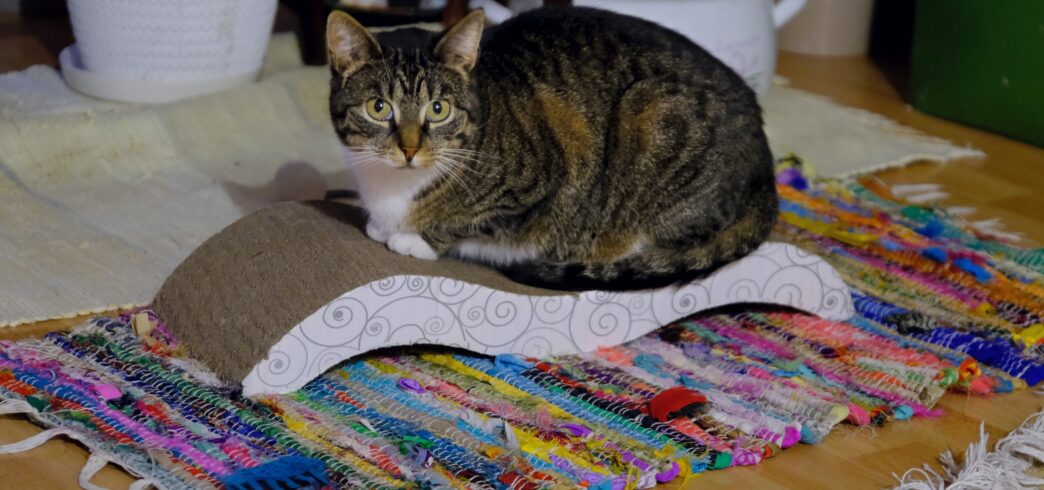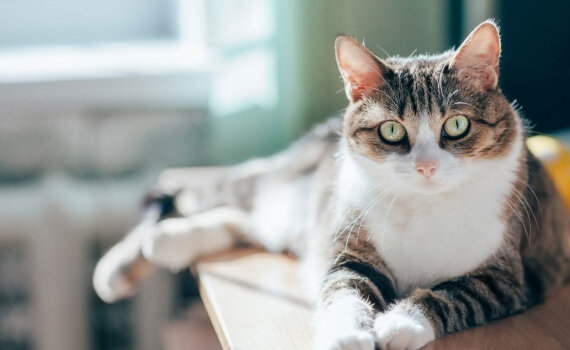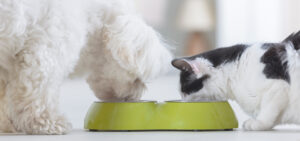
Environmental Enrichment for Indoor Cats: Maximizing Your Home to Better Meet Your Cat’s Needs – Part 2
Category:CatsPart 2: Litter Boxes, Vertical Spaces and Scratching.
by Ingrid Johnson, CCBC (Certified Cat Behavior Consultant)
Litter Boxes
The placement and maintenance of litter boxes is another enormous factor in achieving feline contentedness. Many people provide litter boxes that are hard to access or not clean enough then wonder why their cats are not compliant. Litter boxes should be BIG — one and a half times the length of your cat’s body is ideal. They should have lots of room so that your cat can move and turn around without stepping on a soiled area. Litter boxes should be uncovered. If you’re using storage bin—style boxes or insist on having hooded boxes, be sure they are clear so that your cats can anticipate if someone is coming. Remember that cats are both predator and prey, and using the litter box is one of their most vulnerable moments. They must feel safe or they will find another place to go.
Putting litter boxes behind cat doors or in dead-end areas is a recipe for disaster. All one cat has to do is guard the door and whack the other cat in the head as they come to use the box. It will not be long before the cat being smacked finds a new place to go to the bathroom. Cats want to eliminate in places where their human’s scent is strong, but we always want to hide boxes in places we never go; these two preferences do not mix. Having unobtrusive boxes that are meticulously maintained is, by far, the preferred option. Cats do not want litter box rooms or cat rooms. They would prefer that the boxes be interspersed throughout the home. Bedrooms, bathrooms, home offices, and screen porches are all great places for litter boxes and are a lot more pleasant and less scary than basements, laundry rooms, and closets.
Also, from your cat’s perspective, having multiple boxes all lined up in a row is the same as having only one big box. Offer one more litter box location than you have cats so that all boxes cannot possibly be guarded or in use at any given time. Be sure to scoop daily — no exceptions! Dump and scrub the boxes every few weeks and replace them entirely every two years.
Vertical Space and Scratching
Vertical space and outlets for normal scratching behavior are very important aspects of feline environmental enrichment. Cats are the most three-dimensionally oriented of all of the species we share our homes with. It is absurd to think one can have a cat and NOT facilitate its innate need to climb. Cats take great comfort in being up high. Height allows them to survey a lot of area from a single vantage point and provides a sense of safety and security.
There is not usually one dominant cat in the feline world; it changes based on who owns a given space. The dominant cat changes from room to room, floor to floor, and piece of furniture to piece of furniture. Offering vertical space not only increases the usable square footage of your home, it allows cats to communicate hierarchy of a given space without confrontation. It gives the cats a chance to get up and away from other cats and find a solo resting spot. If you have multiple cats, dogs, or toddlers, vertical spaces can provide great spots for food bowls. I recommend placing cat condos near windows or sliding glass doors to facilitate bird and squirrel watching.
Climbing is also great exercise. Just as foraging toys are as close to letting a mouse loose in the house as we will get, indoor climbing opportunities are as close to providing trees as we can get. Cats need to scratch and scent mark too, and vertical spaces provide outlets for those innate behaviors as well. If you don’t give cats appropriate outlets to satisfy their need for heights, they will fulfill that need in less desirable places such as the top of the kitchen cabinets or refrigerator, the top of your closet on your clean clothes, or on a piece of furniture you would rather they not climb.
While we are on the subject of vertical space, let’s talk about scratching behavior. Cats scratch for four main reasons: to scent mark, to groom their nails, to stretch, and to blow off stress and frustration. Set your cats up for success. Cats do not feel the need to scratch mark in an empty guest bedroom where no one ever goes or in the basement where you spend zero time. Get an attractive post you can be proud of and put it in a prominent, high-traffic area.
Scratching posts should be tall — a minimum of 32 inches —so your cats can achieve a full-body stretch. They should also be sturdy and stable. Cats do not want their scratching posts to move, so don’t waste your money on the kind that hang from the doorknob. The posts should never topple over while your cats are using them. The majority of cats prefer to scratch sisal, but any abrasive texture can work. Do not offer fuzzy, tufted carpet on your post as it teaches your cat to scratch that texture, which could lead to them scratching your carpets or rugs. Most people do not have sisal rugs in their homes, so cats do not make the same connection. Fuzzy, tufted carpet also does not do the job that cats need it to do: remove the sheath of their nails. They need a more abrasive surface to scratch.
Next month we will continue with Part 3, which will cover environmental enrichment for indoor cats relating to fun and play.
Citations
- Young RJ. Environmental enrichment for captive animals. Oxford: Blackwell Science; 2003:1-2.
- Neville PF. An ethical viewpoint: the role of veterinarians and behaviorists in ensuring good husbandry for cats. Paper presented at: American Association of Feline Practitioners; 2002; Tempe, Arizona.
- Overall KL. Manual of clinical behavioral medicine for dogs and cats. St Louis: Elsevier;201 3:106-9.
- Beaver RVG. Feline behavior A guide for veterinarians. 2nd ed. St. Louis: Saunders Co; 2003:54, 221.
Part 1: ;https://www.mistypinespetcompany.com/environmental-enrichment-for-indoor-cats-maximizing-your-home-to-better-meet-your-cats-needs-part-1/
Part 3: https://www.mistypinespetcompany.com/environmental-enrichment-for-indoor-cats-maximizing-your-home-to-better-meet-your-cats-needs-part-3/






